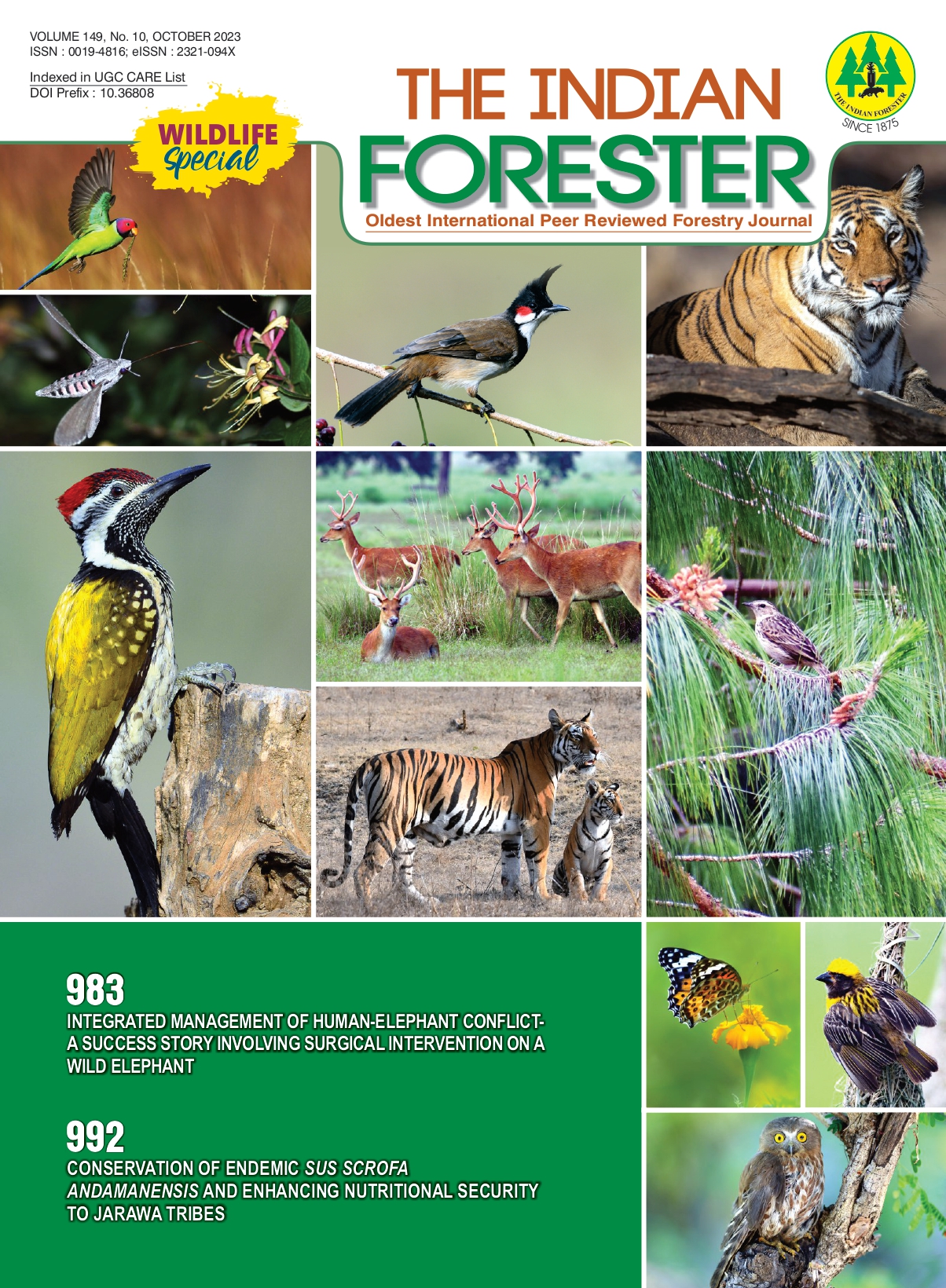Conservation of Endemic Sus scrofa andamanensis and Enhancing Nutritional Security to Jarawa Tribes
DOI:
https://doi.org/10.36808/if/2023/v149i10/169898Keywords:
Andaman Wild Pig, Captive Breeding, Conservation, Jarawa Tribe, Nutritional Security, Species Recovery.Abstract
Andaman Wild Pig (Sus scrofa andamanensis) is an endemic sub-species found in the Andaman and Nicobar Islands. The species is accorded the highest level of protection under the Wildlife (Protection) Act, 1972, of India and is included under Schedule I, Part I, of the Act. It is an important food resource for aboriginal tribes, and the Wildlife (Protection) Act has exempted its hunting by the tribes in the Andaman and Nicobar Islands. Over the years, the population of this endemic species has dwindled due to various factors, and the present population is estimated at about 8,000 individuals on the Andaman Islands. The Andaman and Nicobar Forest Department attempted a captive breeding and re-stocking programme for conserving it and ensuring the nutritional and cultural needs of the aboriginal tribes, besides restoration of the ecological balance of the dwindling population of AWP(Andaman Wild Pig) in the Jarawa Tribal Reserve area in South Andaman Island. In this context, the Chidiyatapu Biological Park in Andaman, which has a similar habitat, was chosen for captive breeding of AWP. The efforts yielded a positive result in 2016, when two piglets were born at the park. Since then, breeding protocol has been firmed up, the number of AWP in captivity has risen at a steady rate and the number of piglets in captivity has increased to 24 in the year 2022. Out of the captive breeding stock, 3 males and 5 females were released in the reserve forest areas inside the Jarawa Tribal Reserve as part of Wildlife week celebrations in 2022. The paper discusses the protocol developed for captive breeding, the Jarawa tribe’s cultural significance in terms of this endemic species and the benefits of mainstreaming biodiversity conservation for the betterment of aboriginal tribes.References
Champion H.G. and Seth S.K. (1968). A revised survey of the forest types of India. Delhi: Government of India Press, 404 p.
De A.K., Jeyakumar S., Kundu M.S., Kundu A. and Sunder J. (2013). Andaman wild pig (Sus scrofa andamanensis): A preliminary report on phenotypic and haematological characteristics. Zoo's PRINT, 28(9): 9-11.
De A.K., Sawhney S., Jeyakumar S. and Bhattacharya D. (2022). First account of maternal lineage of Andaman wild boar (Moupin pig), and endangered endemic species of Andaman archipelago, Explorations in Animal Medical Research, 12(1): 54-68.
Mathur K.K. (1967). Nicobar Islands. National Book Trust, New Delhi.
Oliver W.L.R. (1993). Pigs, Peccaries, and Hippos: Status, Survey and Conservation Action Plan, pp 187. IUCN, Gland, Switzerland.
Oliver W.L.R. (1984a). The distribution, ecology and status of the Andaman Islands wild pigs, with particular reference to their cultural and economic importance to the negrito tribal peoples--outline for a suggested project. (Unpubl.) to Dept. of Environment, Govt. of India: 11 pp.
Oliver W.L.R. (1984b). Introduced and feral pigs. In: Feral Mammals- Problems and Potential. Proc. of the Workshop on Feral Mammals at the 2nd Int. Theriol. Congr., Helsinki, 1982; IUCN, Gland: 87-126.
Oliver W.L.R. (1993). Pigs, Peccaries and Hippos. Prepared by the IUCN/SSC Pigs and Peccaries, Specialist Group and Hippo Specialist Group.
Sanyal A.K., De J.K., Das R.P. and Venkataraman K. (2013). Feasibility study regarding reintroduction of Pygmy Hog (Porcula salvania Hodgson, 1847) at Gorumara National Park, Jaipalguri, West Bengal, Records of the Zoological Survey of India, 113(Part-1): 01-24.
Sivakumar K. (2004). Introduced mammals in Andaman & Nicobar Islands (India): A conservation perspective. Aliens, 17(11).
Sunder A.J., Jeyakumar S., Verma S.K., Kundu M.S., De A.K. and Shrivastava R.C. (2010). Livestock and poultry production policy for Andaman and Nicobar Islands: a scientific perspective, published by Director, CIARI, Port Blair. pp 1-48.
Tewari D.N. (1984). Tour note of visit to Andaman and Nicobar Islands between 18-23 January, 1984.
Downloads
Downloads
Published
How to Cite
Issue
Section
License
Unless otherwise stated, copyright or similar rights in all materials presented on the site, including graphical images, are owned by Indian Forester.





